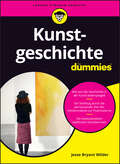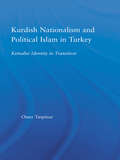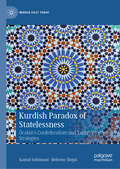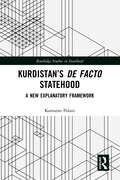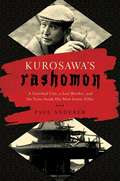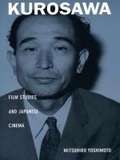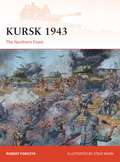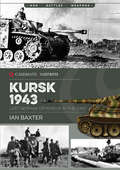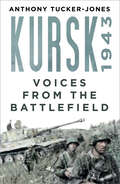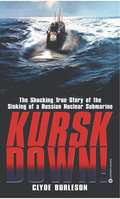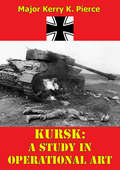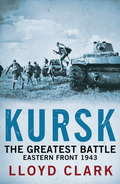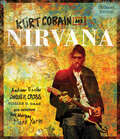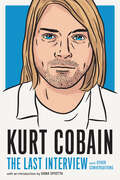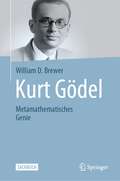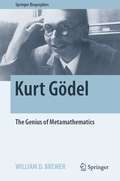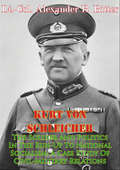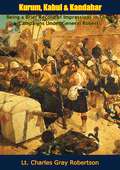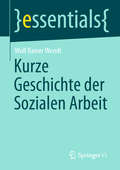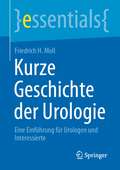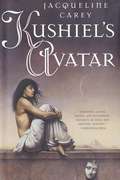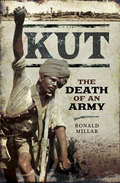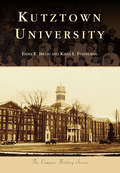- Table View
- List View
Kunstgeschichte für Dummies (Für Dummies)
by Jesse Bryant WilderBegeben Sie sich mit "Kunstgeschichte für Dummies" auf eine Reise durch Zeit und Raum: Lernen Sie Kunstwerke aus aller Welt kennen und betrachten Sie gemeinsam mit Jesse Wilder Kunstwerke aller Epochen: von den ersten Höhlenzeichnungen über die griechische und römische Kunst, Gothik und Barock, Impressionismus und Expressionismus bis in die Gegenwart. Erfahren Sie, was typisch für die einzelnen Epochen und Kunststile ist, wie die Kunst mit den historischen Ereignissen ihrer Entstehungszeit zusammenhängt, welche Künstler wann welche Kunstwerke schufen und welche Museen besuchenswert sind.
Kurdish Nationalism and Political Islam in Turkey: Kemalist Identity in Transition (Middle East Studies: History, Politics & Law)
by Omer TaspinarThis text is an attempt to study Turkey's national and secular identity in light of the challenges posed by Kurdish nationalism and political Islam.
Kurdish Paradox of Statelessness: Öcalan's Confederalism and Turkeyification Strategies (Middle East Today)
by Kamal Soleimani Behrooz ShojaiThis book critically examines Abdullah Öcalan’s proposal of "democratic confederalism," introduced in 2005, and its theoretical and practical implications. Despite its claims to transcend the nation-state model, Öcalan’s project leaves the colonial structures of the Turkish, Persian, and Arab states unchallenged, legitimizing their assimilatory and genocidal tendencies. It fails to secure Kurdish self-determination or protect linguistic and cultural rights, including mother-tongue education. The study interrogates these contradictions, offering a comprehensive critique of Öcalan’s ideology and its limited impact on governance, Kurdish identity, and aspirations for autonomy. Drawing on Öcalan’s original Turkish writings, the book challenges prevailing scholarship that often relies on selective translations and sympathetic interpretations. It reveals the foundational limitations of Öcalan’s approach, exposing the structural barriers it sustains and its complicity in perpetuating Turkification tendencies under the guise of Kurdish politics.
Kurdistan’s De Facto Statehood: A New Explanatory Framework (Routledge Studies in Statehood)
by Kamaran PalaniThis book explains the dynamics and nature of Iraqi Kurdistan’s de facto statehood since its inception in 1991, in particular the vicissitudes de facto independence since then. The work examines de facto statehood in Kurdistan, and uncovers the dynamics of de facto statehood in Kurdistan at internal, national and international levels. Kurdistan’s de facto statehood is shown to be inherently characterised by fluidity. In this book, fluidity is defined as a highly unstable feature of de facto statehood in the relational context of non-recognition. The book includes interviews with a number of high-profile politicians and policy makers from the region. These provide unique insights into such issues as the four main factors at play in the fluidity of the de facto state of Kurdistan: the balance of power between Erbil and Baghdad; the level and form of internal fragmentation; the change of strategies to gain international recognition; and the uncertain and fluctuating external support. This book will be of much interest to students of statehood studies, Middle Eastern politics, and International Relations.
Kurosawa's Rashomon: A Vanished City, a Lost Brother, and the Voice Inside His Iconic Films
by Paul AndererA groundbreaking investigation into the early life of the iconic Akira Kurosawa in connection to his most famous film—taking us deeper into Kurosawa and his world. Although he is a filmmaker of international renown, Kurosawa and the story of his formative years remain as enigmatic as his own Rashomon. Paul Anderer looks back at Kurosawa before he became famous, taking us into the turbulent world that made him. We encounter Tokyo, Kurosawa’s birthplace, which would be destroyed twice before his eyes; explore early twentieth-century Japan amid sweeping cross-cultural changes; and confront profound family tragedy alongside the horror of war. From these multiple angles we see how Kurosawa’s life and work speak to the epic narrative of modern Japan’s rise and fall. With fresh insights and vivid prose, Anderer engages the Great Earthquake of 1923, the dynamic energy that surged through Tokyo in its wake, and its impact on Kurosawa as a youth. When the city is destroyed again, in the fire-bombings of 1945, Anderer reveals how Kurosawa grappled with the trauma of war and its aftermath, and forged his artistic vision. Finally, he resurrects the specter and the voice of a gifted and troubled older brother—himself a star in the silent film industry—who took Kurosawa to see his first films, and who led a rebellious life until his desperate end. Bringing these formative forces into focus, Anderer looks beyond the aura of Kurosawa’s fame and leads us deeper into the tragedies and the challenges of his past. Kurosawa’s Rashomon uncovers how a film like Rashomon came to be, and why it endures to illuminate the shadows and the challenges of our present.
Kurosawa: Film Studies and Japanese Cinema
by Mitsuhiro YoshimotoThe films of Akira Kurosawa have had an immense effect on the way the Japanese have viewed themselves as a nation and on the way the West has viewed Japan. In this comprehensive and theoretically informed study of the influential director's cinema, Mitsuhiro Yoshimoto definitively analyzes Kurosawa's entire body of work, from 1943's Sanshiro Sugata to 1993's Madadayo. In scrutinizing this oeuvre, Yoshimoto shifts the ground upon which the scholarship on Japanese cinema has been built and questions its dominant interpretive frameworks and critical assumptions. Arguing that Kurosawa's films arouse anxiety in Japanese and Western critics because the films problematize Japan's self-image and the West's image of Japan, Yoshimoto challenges widely circulating clichés about the films and shows how these works constitute narrative answers to sociocultural contradictions and institutional dilemmas. While fully acknowledging the achievement of Kurosawa as a filmmaker, Yoshimoto uses the director's work to reflect on and rethink a variety of larger issues, from Japanese film history, modern Japanese history, and cultural production to national identity and the global circulation of cultural capital. He examines how Japanese cinema has been "invented" in the discipline of film studies for specific ideological purposes and analyzes Kurosawa's role in that process of invention. Demonstrating the richness of both this director's work and Japanese cinema in general, Yoshimoto's nuanced study illuminates an array of thematic and stylistic aspects of the films in addition to their social and historical contexts. Beyond aficionados of Kurosawa and Japanese film, this book will interest those engaged with cultural studies, postcolonial studies, cultural globalization, film studies, Asian studies, and the formation of academic disciplines.
Kursk 1943
by Robert Forczyk Steve NoonKursk 1943 focuses on the northern front and the battle of Kursk, and period of July 5th to August 18th, 1943, covering both the German offensive and the Soviet counteroffensive - Model's AOK 9 pitted against General Konstantin Rokossovsky's Central Front.After recovering from the Stalingrad debacle, Hitler intended to conduct a limited objective offensive (using the new Panther and Tiger tanks) in the summer of 1943 in order to eliminate the Soviet Kursk salient. He intended to conduct a classic pincer attack of the kind that succeeded during the 1942 Kharkov campaign and hoped that the resulting heavy loss of troops and material inflicted on the Red Army would give the Wehrmacht time to recover its strength. Hitler chose two of his best field commanders - Generalfeldmarschall Erich von Manstein and Generaloberst Walter Model - to lead the two pincers against the Kursk salient in Operation Zitadelle. Manstein would attack from the south with Heeresgruppe Süd, while Model attacked from the north with his heavily reinforced AOK 9.Model was not in favor of the offensive because he believed the Soviet defenses were too dense, but he dutifully mounted a full-scale offensive from 5 to 10 July 1943. Model's forces included two battalions of the new Ferdinand tank destroyers and a battalion of Tiger tanks, but were only capable of chewing its way through the first line of Soviet defenses. Although Model had failed to accomplish a breakthrough, his forces were far from spent. When the Soviets mounted their own Operation Kutusov to collapse the German-held Orel salient, Model had sufficient forces left to conduct a fighting retreat back to the Hagen Line. By 18 August 18th 1943, the Soviets had liberated Orel and pushed Model's forces back, but suffered over 400,000 casualties and the loss of 2,500 tanks. The Germans had succeeded in gaining a tactical victory that mauled three Soviet tank armies, although the Red Army had achieved an operational-level victory by liberating Orel.
Kursk 1943: Last German Offensive in the East (Casemate Illustrated #Cis0014)
by Ian BaxterAn illustrated history of World War II&’s largest tank battle that went down near the Russian city. In the summer of 1943, Nazi Germany launched Operation Zitadelle (Citadel), aimed at cutting off Soviet forces in the Kursk salient. This offensive resulted in the Battle of Kursk. Kursk quickly became a fierce contest of attrition, as Wehrmacht and elite Waffen-SS Panzer-Divisions with their powerful Tiger and Panther tanks unsuccessfully tried to hammer their way through the intricate lines of strong Soviet defensive positions. What followed was unabated fighting for two weeks as German units were slowly and systematically ground down in a series of brutal armored battles. During this ferocious fighting the Red Army savagely contested every foot of ground, finally ending German invincibility forever. For the first time in its short history, the blitzkrieg concept had failed. The reverberations caused by the defeat at Kursk were immense, and never again did the German war machine go on the offensive in the East. Stiff defensive action was now the stratagem placed upon the dwindling Panzerwaffe right to the gates of Berlin. With comprehensive captions and text, Kursk 1943 tells the story of this dramatic battle using rare and unpublished photographs, maps, and highly detailed artist profiles. The book reveals the events leading up to the battle in the first half of 1943 and the buildup of forces by both sides before their climatic showdown at Kursk.
Kursk 1943: Voices from the Battlefield
by Anthony Tucker-JonesIn 1943, as war raged along the Eastern Front, the German forces attempted to push further east in the brutal Operation Citadel, which saw one of the largest armoured clashes in history in the Battle of Prokhorovka. Countered by two Soviet attacks, this operation saw the tide turn on the Eastern Front. For the first time a German offensive was halted in its tracks and the Soviets ended the conflict as the decisive victors. With a loss of over 200,000 men on both sides, this two-month offensive was one of the costliest of the war. In this dramatic new study, Anthony Tucker-Jones reassesses this decisive tank battle through the eyes of those who fought, using recently translated first-person accounts. This is one volume that no military history enthusiast should be without.
Kursk Down!: The Shocking True Story of the Sinking of a Russian Nuclear Submarine
by Clyde BurlesonBlack, sleek, and state of the art, the nuclear submarine Kursk was the pride of the Russian fleet. But on August 12, 2000, while on maneuvers in the Barents Sea, the Kursk, hailed as "unsinkable," was blown apart by mysterious explosions. She went down hard with a crew of 118 men trapped inside. For government and military brass far from the scene, the art of spin became more important than the need to save lives. For those on board, the hunger to live summoned astonishing reserves of discipline and heroism. For the rescuers poised at the surface, the devotion to their mission proved more powerful than the savagery of the elements and time itself.
Kursk: A Study In Operational Art
by Major Kerry K. PierceThis monograph examines the practice of operational art from the perspective of the Kursk Campaign of July-Oct., 1943. The study begins by presenting the German and Russian campaign plans as examples of two different methods of achieving a desired end state. Each plan's vision of the future was heavily influenced by the nature of the strategic situation and the personalities of the two principal artists: Adolf Hitler and Marshal Georgii Zhukov. These two leaders had vastly different understandings of strategic possibilities, time-space dimensions of the battlefield, and the means required to achieve their desired end states. The success of Zhukov's campaign plan was directly related to his linkage of appropriate means and methods toward a desired end state, while Hitler's failure represented a failure to do likewise. The monograph also uses Kursk to examine several theoretical concepts of war. These include the relative strength of offense and defense, culminating points, the art of combinations, use of reserves, and the center of gravity.The Russian decision to defend first against an expected German offensive is an excellent example of the use of operational art. Acting on the information of the LUCY espionage network, Zhukov constructed his campaign around an unprecedented tactical defensive system in an effort to destroy the German armored formations as they attacked toward Kursk. He intended to initiate his counteroffensive at the point where the German panzer corps had been so attrited that they would not be able to prevent a Russian onslaught which would expel all German forces from the Donetz Basin. German operational flexibility, which had been the hallmark of their previous campaigns, was eliminated by Hitler's centrally devised and executed plan, reducing commanders such as Manstein and Model to mere tactical actors. In the end the Russian victory was a complete one: tactical, operational and strategic.
Kursk: The German View
by Steven H. NewtonFirsthand accounts of the German commanders who planned and executed the largest tank battle in history
Kursk: The Greatest Battle *special Sales*
by Lloyd Clark5th July 1943: the greatest land battle of all time began around the town of Kursk in Russia. This epic confrontation between German and Soviet forces was one of the most important military engagements in history and epitomised 'total war'.It was also one of the most bloody, characterised by hideous excess and outrageous atrocities. The battle concluded with Germany having incurred nearly three million dead and the Soviet Union a staggering ten million. It was a monumental and decisive encounter of breathtaking intensity which became a turning point, not only on the Eastern Front, but in the Second World War as a whole. Using the very latest available archival material including the testimonies of veterans and providing strategic perspective alongside personal stories of front line fighting, Lloyd Clark has written a lucid, enthralling and heart-stopping account of this incredible battle.
Kursk: The Greatest Battle *special Sales*
by Lloyd Clark5th July 1943: the greatest land battle of all time began around the town of Kursk in Russia. This epic confrontation between German and Soviet forces was one of the most important military engagements in history and epitomised 'total war'.It was also one of the most bloody, characterised by hideous excess and outrageous atrocities. The battle concluded with Germany having incurred nearly three million dead and the Soviet Union a staggering ten million. It was a monumental and decisive encounter of breathtaking intensity which became a turning point, not only on the Eastern Front, but in the Second World War as a whole. Using the very latest available archival material including the testimonies of veterans and providing strategic perspective alongside personal stories of front line fighting, Lloyd Clark has written a lucid, enthralling and heart-stopping account of this incredible battle.
Kurt Cobain and Nirvana
by Mark Yarm Charles R. Cross Gillian G. Gaar Bob Gendron Andrew Earles Todd MartensNow updated, the first complete illustrated history of the band: “A feast for fans’ eyes.” —SpinKurt Cobain, Dave Grohl, and Krist Novoselic comprised Nirvana, the band that unintentionally tore the music world asunder with the 1991 album Nevermind, which continues to rattle speakers today. This book tells the fully illustrated story of the band that spoke for Generation X in the ‘90s.Kurt Cobain and Nirvana reveals the history with fresh eyes, telling the tale of a group that instigated a return to punk-inspired rock. This updated edition features the writing of a talented team of prominent music journalists. It also includes performance and backstage photography, as well as handbills, singles, ticket stubs, gig posters, and other memorabilia that complement the narrative, as well as album reviews, gear breakdowns, and mini-synopses of Cobain’s fifty all-time favorite albums. Nirvana’s ride was a wild one—and all too brief. In these pages, it’s recalled in vivid, poignant detail.“Emphasizes the visual ephemera of Nirvana’s career: photographs, concert posters, ticket stubs, t-shirts, infant onesies, even a casting call for the ‘Smells Like Teen Spirit’ video.” —Pitchfork
Kurt Cobain: and Other Conversations (The Last Interview Series)
by Melville HouseKurt Cobain burst into American consciousness with a vengeance with the release of Nevermind, an instant classic that defined a sound and a generation. Three years later, he was dead of suicide, leaving a meteoric career and a cultural influence that would never wane.As the lead singer and guitarist of Nirvana, Kurt Cobain changed American music as few musicians ever have. His instantly identifiable raspy croon, his slash-and-burn guitar playing, and his corrosive and poetic lyrics made him a hero to a generation of lost souls. In interviews Cobain was funny, thoughtful, sarcastic, impassioned, and even kind. This collection of interviews provides a look at a man who was too often misunderstood.
Kurt Gödel: Metamathematisches Genie
by William D. BrewerZu seinen Lebzeiten war Kurt Gödel außerhalb der Fachwelt der Mathematiker, Philosophen und theoretischen Physiker kaum bekannt. Zu Beginn seiner Karriere schuf er beeindruckende Arbeiten zur Vollständigkeit und Beweisbarkeit formaler logischer Systeme, die zu seiner Dissertation und seiner Habilitations-schrift wurden und ihn unter Fachleuten weltberühmt machten. Seine Unvoll-ständigkeitssätze läuteten das Ende der formal-logischen Programme der Logizisten (Russell et al.) und der Formalisten (Hilbert et al.) ein. Später erzielte er auch signifikante Ergebnisse in der Mengenlehre. Nach seiner Emigration in die USA (Princeton), widmete er sich mehr der Philosophie, dem Leitmotiv seines Lebens, und er fand auch eine einzigartige Lösung zu Einsteins Feld-gleichungen der Gravitation, sein “Gödel-Universum“. Dieses Buch beschreibt sowohl den Gödel, der ein genialer Wissenschaftler war, und der gewagte und neuartige Hypothesen zu den Fundamenten der Mathe-matik und Physik hervorbrachte, ‒ als auch den Gödel, der ein perfekter Rationalist war, aber sein Alltagsleben nur mit Mühe meistern konnte und zeitlebens unter Depressionen, Angstneurosen und Hypochondrie litt. Ein Leben voller Paradoxen, in dem er trotz all seiner psychischen Probleme Beachtliches leistete und zu einem Vorbild für viele jüngere Wissenschaftler wurde. Das Buch liefert den Kontext zu seinen Errungenschaften, die ein verblüffend breites Spektrum intellektueller Unternehmungen darstellen, und zu seiner zunehmenden Geisteskrankheit; und es zeigt, wie er eine lange und erfolgreiche Karriere mit Hilfe seiner loyalen Ehefrau Adele und einigen seiner Freunde durchlaufen konnte. Dies ist eine faszinierende Geschichte der wissen-schaftlichen Genialität und der menschlichen Natur.
Kurt Gödel: The Genius of Metamathematics (Springer Biographies)
by William D. BrewerDuring his lifetime, Kurt Gödel was not well known outside the professional world of mathematicians, philosophers and theoretical physicists. Early in his career, for his doctoral thesis and then for his Habilitation (Dr.Sci.), he wrote earthshaking articles on the completeness and provability of mathematical-logical systems, upsetting the hypotheses of the most famous mathematicians/philosophers of the time. He later delved into theoretical physics, finding a unique solution to Einstein’s equations for gravity, the ‘Gödel Universe’, and made contributions to philosophy, the guiding theme of his life. This book includes more details about the context of Gödel’s life than are found in earlier biographies, while avoiding an elaborate treatment of his mathematical/scientific/philosophical works, which have been described in great detail in other books. In this way, it makes him and his times more accessible to general readers, and will allow them to appreciate the lasting effects of Gödel’s contributions (the latter in a more up-to-date context than in previous biographies, many of which were written 15–25 years ago). His work spans or is relevant to a wide spectrum of intellectual endeavor, and this is emphasized in the book, with recent examples. This biography also examines possible sources of his unusual personality, which combined mathematical genius with an almost childlike naiveté concerning everyday life, and striking scientific innovations with timidity and hesitancy in practical matters. How he nevertheless had a long and successful career, inspiring many younger scholars along the way, with the help of his loyal wife Adele and some of his friends, is a fascinating story in human nature.
Kurt Von Schleicher—The Soldier And Politics In The Run-Up To National Socialism: A Case Study Of Civil-Military Relations
by Lt.-Col. Alexander B. BitterThis monograph assesses the adequacy of current United States joint campaign planning doctrine within the context of conventional operations between similar forces within a theater of war. The study focuses on five key doctrinal planning concepts-- center of gravity, decisive points, operational reach, balance, and branches and sequels.Joint planning doctrine directly influences the national security of the United States. The foundation of effective and rigorous military planning is the body of professional doctrine that shapes and animates the planning process. The use of poor or insufficient planning doctrine may result in flawed campaign plans which unnecessarily risk the resources and prestige of the United States as well as the lives of America's servicemen and women. Successful campaigns, developed from intellectually sound and militarily thorough planning doctrine, are the building blocks of national victory in war.A case study of Japanese campaign planning efforts at the beginning of 1942 and the retroactive application of selected joint doctrine planning concepts to these efforts is the method and medium of inquiry. Japanese operational planning in 1942 contained a number of complex and difficult challenges. These challenges present a rigorous test for current doctrine. Historically, this process resulted in the disastrous attempt to invade Midway Island. Joint doctrine is assessed as adequate if its application to 1942 Japanese planning would have resulted in the development of a campaign plan potentially more successful than the historical Midway operation.This paper concludes that the rigorous application of current joint doctrine by the Japanese to the planning for the 1942 campaign would have resulted in the production of a more thorough, resilient, and potentially more successful plan. Joint campaign planning doctrine, a way to think about warfare, would have overcome the challenges involved in planning this campaign.
Kurum, Kabul & Kandahar: Being a Brief Record of Impressions in Three Campaigns Under General Roberts
by Lt. Charles Gray RobertsonOriginally published shortly after the end of the Second Anglo-Afghan War in 1881, this book by a British veteran, Lt. Charles Gray Robertson, provides the reader with a first-hand account at the colonialism during nineteenth century India and Afghanistan.
Kurze Geschichte der Sozialen Arbeit (essentials)
by Wolf Rainer WendtIn einer verdichteten Darstellung wird die Entwicklung sozialer Betätigung und ihrer Professionalisierung beschrieben – von den Gesellschaften der Aufklärung über soziale Bewegungen und Antworten international auf die soziale Frage in öffentlicher und freier Armenpflege und die Entfaltung von social work hin zu seinen Ausprägungen im Wohlfahrtsstaat unter Bedingungen des sozialen und globalen Wandels.
Kurze Geschichte der Urologie: Eine Einführung für Urologen und Interessierte (essentials)
by Friedrich H. MollDie historische Entwicklung der Fachdisziplin der Urologie ist spannend und interessant. Insbesondere, weil die Wurzeln des Faches u.a. in Deutschland und Österreich liegen.In diesem Essential werden wichtige Schlüsselmomente aus der Urologie, Andrologie und benachbarter Gebiete zusammengetragen. Kurzweilig erhält der Leser einen Überblick zur historischen Entwicklung dieses medizinischen Fachgebietes. Neben den großen Themenkomplexen wie der Steintherapie, Prostatachirurgie, Uro-Radiologie und Zystoskopie-Endoskopie finden auch spezielle Aspekte der Entwicklung der medizinischen Fachgesellschaft, der Urodynamik und der Transplantationsmedizin Berücksichtigung. Die Zielgruppen Urologen, angehende Fachärzte der Urologie, interessierte Mediziner, Allgemeinärzte, Medizinhistoriker
Kushiel's Avatar (Kushiel's Legacy #3)
by Jacqueline CareyIn this final volume of the Kushiel trilogy, Milisande's son disappears and Hyacinthe is still imprisoned as the Master of the Straits. Once more, Phedre and Jocelyn must travel far and undergo strange adventures to eventually succeed. This is a blend of fantasy and romance with a little spice thrown in.
Kut: The Death of an Army
by Ronald MillarKut: The Death of an Army is the fascinating, yet largely forgotten, story of the British-Indian Army, which was besieged in Mesopotamia from 1915 to 1916. It is an expert account of the tragic five-month Turkish siege, in which their enemies essentially outlasted them.The author reveals the day-to-day preoccupations of not only the Anglo-Indian forces, but their enemies the Turks as well as local civilians caught in the chaos. Throughout the campaign, the British were beaten back by the Turks, and the ever-prevailent human suffering of the men, so far away from home in this foreign ground, less than helped the cause: starvation, heavy shelling, inadequate medical supplies and disease were all taking their toll. By the end of the campaign, approximately 30,000 British and Indian soldiers had lost their lives.This informative book will be of interest to anyone wanting a concise and accessible introduction to the conflict and will be essential reading for both students of the First World War, as well as those who have a penchant for military history in general.
Kutztown University (Campus History)
by Kayla L. Fusselman Emma E. BilligKutztown University (KU) traces its origins to the Fairview Seminary. In 1860, Henry R. Nicks opened Fairview Seminary as a select school where more advanced subjects than those offered in the area were taught. In 1864, Nicks opened a new Maxatawny Seminary on the site where KU's Old Main stands today. With growth, efforts were made to convert the seminary into a public state normal school. On September 15, 1866, Maxatawny Seminary officially became Keystone State Normal School (KSNS). KSNS was dedicated to preparing students for the teaching profession. With emphasis placed on student life and the school's Pennsylvania German heritage, this book tells the story of KU from its modest beginnings as a teacher training school to its current mission of providing high-quality education.
